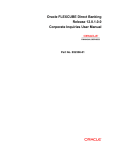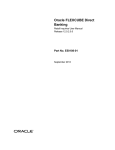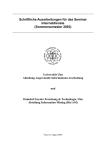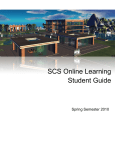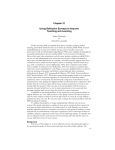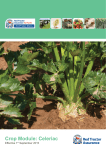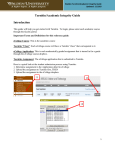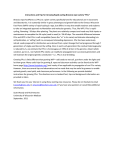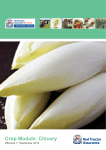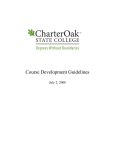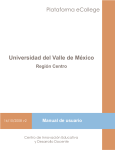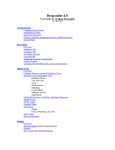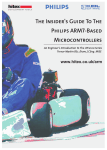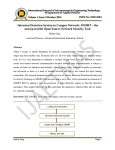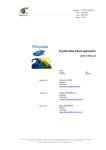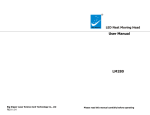Download COURSE SYLLABUS PLS 115 – Introduction to Plant Science
Transcript
COURSE SYLLABUS PLS 115 – Introduction to Plant Science Summer I - 2014 Instructor: Jim Heitholt Virtual Office Hours: Monday, Tuesday, Wednesday, 1 pm to 5 pm (these hours are likely to be in my 146 AGIT office in case you are on campus) I also intend to be in the office on Thursdays and Fridays, if it is not a lab day. Office Phone: 903-886-5357 University Email Address: [email protected] COURSE INFORMATION Materials – Textbooks, Readings, Supplementary Readings Textbook(s) Required Plant Science: Growth, Development, and Utilization of Cultivated Plants, 4 th edition (McMahon et al., 2007) ISBN: 0-13-114075-2 OR Plant Science: Growth, Development, and Utilization of Cultivated Plant, 5th edition (McMahon et al., 2011) ISBN: 01-35-014077 Handouts will be provided in the lab. Course Description - Lecture Lectures will cover principles of plant growth, crop production, ornamental plant culture, and production horticulture. The “Lecture” component will be handled through ECollege. Course Description – Lab The “lab” will provide students with hands-on exercises in the lab, greenhouse, and field. Students will grow agronomic and vegetable crops, separate plants into their morphological components, prepare and view cross sections of leaves and stems, alter light sources, test different soil fertility treatments, administer water stress and measure plant water relations, emasculate blooms, alter environmental conditions to promote flowering, quantify yield components, and examine genetic variability. Prerequisites None. Course Learning Outcomes – Lecture 1. The student will describe two differences between the morphological and physiological process used by an annual grain crop to produce yield, a perennial fruit or nut crop to produce yield, and a forage crop to produce biomass. Satisfies “Critical Thinking” Core Objective. Assessed through exit test. 2. The student will be able to describe in writing or via PowerPoint the symptoms of nitrogen and phosphate deficiency in leaves. Satisfies “Communication” Core Objective. Take-home assignment. 3. The student will be able to describe the assimilate composition of seed from corn, sunflower, and soybean and how it is used to develop dietary guidelines in livestock and humans. Satisfies “Empirical and Quantitative Skills” Core Objective. Assessed through exit test. 4. While working in groups of three students, the team will utilize course material and external websites to determine how genetic diversity is used to create crop hybrids and cultivars that are adapted to specific production regions. Satisfies “Teamwork” Core Objective. Assessed through a late-semester class exercise. Course Learning Outcomes – Lab 1. The student will successfully separate the stamen and pistil floral parts from each other on a cotton flower or similar species. The student will then describe what precautions are taken to ensure that cross-pollination occurs or that self-pollination occurs. Assessed through exit test. 2. When presented with live clover, bermudagrass, potato, and onion plants, the students will be able to describe the modified stems of these species and how those modified stems are used to vegetatively propagate those species. Assessed through a late-semester class exercise. 3. The student will be given a leaf and be asked to explain the process of how leaf chlorophyll concentration is determined. Assessed through exit test. 4. While working in groups of three students, the team will be asked to choose a certain region of the country (in United States) and develop a sustainable crop-rotation strategy. Assessed through a late-semester class exercise. TECHNOLOGY REQUIREMENTS You will need regular access to a computer with a broadband Internet connection. The minimum computer requirements are: (1) Any current Flash-compliant browser (e.g., Internet Explorer 7 or Firefox 3.0) (2) 512 MB of RAM, 1 GB or more preferred (3) Broadband connection required courses are heavily video intensive (4) Video display capable of high-color 16-bit display 1024 x 768 or higher resolution (5) A sound card and speakers or headphones (6) Current anti-virus software must be installed and kept up to date (7) Some classes may have specific class requirements for additional software. These requirements will be listed on the course offerings page. Most home computers purchased within the last 3 to 4 years meet or surpass these requirements. (8) You will need some additional free software for enhanced web browsing. Ensure that you download the free versions of the following software: a. Adobe Reader b. Adobe Flash Player (9) At a minimum, you must have Microsoft Office 2003, XP, 2007 or Open Office. Microsoft Office is the standard office productivity software utilized by faculty, students, and staff. Microsoft Word is the standard word processing software, Microsoft Excel is the standard spreadsheet software, and Microsoft PowerPoint is the standard presentation software. Copying and pasting, along with attaching/uploading documents for assignment submission, will also be required. If you do not have Microsoft Office, you can check with the bookstore to see if they have any student copies. ACCESS AND NAVIGATION eCollege Access and Log in Information This course will be facilitated using eCollege, the Learning Management System used by Texas A&M University-Commerce. To log in to the course, go to the following link: http://www.tamuc.edu/myleo.aspx. You will need your CWID and password to log in to the course. If you do not know your CWID or have forgotten your password, contact Technology Services at 903.468.6000 or go to the following link: [email protected]. Once you log in to eCollege, click on My Courses and select PLS 115, Introduction to Plant Science. It is strongly recommended that you perform a “Browser Test” prior to the start of your course. To launch a browser test, login to ECollege, click on the ‘myCourses’ tab, and then select the “Browser Test” link under Support Services. Course Navigation All lecture aspects of this course, including presentations, assignments, readings, and quizzes will be completed / turned in through eCollege. Your grades will also be available in eCollege. After logging in to the course, students will notice that the unit content area is located on the left navigation bar. These unit content areas are identified by subject covered in that unit (this corresponds to the course schedule located in the syllabus). Student needs to access course materials by clicking on the proper unit content area. Students needs to read the unit overview that contains information about what is to be covered in class, along with a series of unit tasks (these tasks correspond to the links available in each unit and to what appears in the syllabus). Then, students need to click on the unit content item(s) links and take the time to read/view any material/presentations/assignments that are posted. The lecture/presentation is an attempt to integrate information from the course readings and includes information from the text/readings as well as other information that are considered important to your understanding of the subject. This entire lecture component of the course is online. You understand the importance of your having an internet connection all the time. All lecture-related communications will be web-based. When you sign in to the course you will see a Welcome video. In the left navigation menu the following items are found, under Course Home: Syllabus: Please take a few moments to read through the Syllabus carefully. In the Begin Here unit there will be a short quiz over the syllabus. Student Lounge: This is place you can discuss any issues related to this course with your classmates. The instructor will monitor these discussions. Please be respectful to each other. You are expected to be professional and responsible users of this online course. Remember to use good Netiquette manners in all online communications. Netiquette guidelines can be found in DocSharing. There is also a link to the Netiquette web site in the Webliography. The Netiquette Guidelines are in the Start Here unit. Virtual Office: (See below). Library: Databases & Tutorials To access the Library databases and Library tutorials click on the Library link in the course or you may open a separate browser session. Minimize your eCollege session and open another browser window going to the Library's web site directly: http://www.tamuc.edu/library not from within eCollege. Currently enrolled students wanting to access databases from abroad: 1. Install the VPN client software from: https://vpn.tamuc.edu. 2. Open the installed VPN application and enter personal login information as follows: Login: student\(your CWID) (Example: student\12345678) Password: (enter your myLeo password) Technical Support: Contact eCollege for Technical Support: (See below) Contact Your Instructor: If you have questions pertaining to the content of this course (e.g., questions about an exam, course due dates, grades, etc.), please contact your instructor via email or through the "Virtual Office." Tools: Across the top of the course screen. Gradebook: Check the gradebook often to keep track of your grades! If you see the word “Read” in the grade area, click on it. There will be a message, from the instructor, about your assignment. The message will give instructions on what changes need to be made to the assignment, before resubmitting it to the Dropbox. If you have any questions or concerns about your grades, please, email the instructor. Email: You can send emails to your classmates individually, the instructor, or to the entire class. Remember to use Netiquette when sending emails. Live: Click here to attend our ClassLive sessions. My office hours in ClassLive will be Tuesdays at 5 pm to 6 pm (please note the Mon-Wed, 1 to 5 pm office hours, mentioned earlier). If you need a private ClassLive session, for emergency situations only, please make an appointment. DocSharing: Documents such as templates, rubrics, and example of assignments are uploaded to DocSharing for your use. Dropbox: All assignments are submitted in the Dropbox. Journal: The journal can be used to keep a personal record of this course. The instructor will not read these entries. Webliography: The addresses to websites, URL, are entered here. Tech Support: If you have any technical issues with eCollege, click on this link. Help: This is the link to the User’s Manual for this course. If you have questions on how to submit an assignment to the Dropbox, click on Help, type Dropbox in the Search window and click Search. From the menu, locate Submit an Assignment. COMMUNICATION AND SUPPORT Interaction with Instructor Statement: The instructor’s primary form of communication with the class will be through Email. Any changes to the syllabus or other important information critical to the class will be disseminated to students in this way via your official University Email address available to the instructor through MyLeo and in Announcements. It will be your responsibility to check your University e-mail as the instructor plans to send you important messages regularly. Students who e-mail instructor outside of regular office hours can expect a reply within 24 hours. Students who Email me during holidays or over the weekend can expect a reply by the end of the next regularly scheduled business day. Virtual Office Welcome to my office. This space is set aside for students to ask course related questions. Place any questions or concerns about the course here and they will answered within 24 hours on weekdays. It is possible that I will answer all threads during my office hours as posted on the syllabus. Please feel free to answer one another's questions. I will check answers (as well as questions) for correctness, but do not hesitate to respond to a posting if you feel you can answer the question thoroughly and directly. eCollege Student Technical Support: Texas A&M University-Commerce provides students technical support in the use of eCollege. The student help desk may be reached by the following means 24 hours a day, seven days a week. Chat Support: Click on 'Live Support' on the tool bar within your course to chat with an eCollege Representative. Phone: 1-866-656-5511 (Toll Free) to speak with eCollege Technical Support Representative. Email: [email protected] to initiate a support request with eCollege Technical Support Representative. Help: Click on the 'Help' button on the toolbar for information regarding working with eCollege (i.e. how to submit to dropbox, and how to post to discussions, etc.) For assistance with the library: To access the Library databases and tutorials click on the Library link under Course Home or minimize your eCollege session and open another browser window going to the Library's web site directly, at the following link: http://www.tamuc.edu/library not from within eCollege. myLeo Support Your myLeo email address is required to send and receive all student correspondence. Please email [email protected] or call us at 903-468-6000 with any questions about setting up your myLeo email account. You may also access information at the following link https://leomail.tamuc.edu Internet Access An Internet connection is necessary to participate in discussions and assignments, access readings, transfer course work, and receive feedback from your professor. View the requirements as outlined in Technology Requirements above for more information. Learner Support Go to the following link One Stop Shop- created to serve you by attempting to provide as many resources as possible in one location. Go to the following link Academic Success Center- focused on providing academic resources to help you achieve academic success. COURSE AND UNIVERSITY PROCEDURES/POLICIES Course Specific Procedures Academic Honesty Students who violate University rules on scholastic dishonesty are subject to disciplinary penalties, including (but not limited to) receiving a failing grade on the assignment, the possibility of failure in the course and dismissal from the University. Since dishonesty harms the individual, all students, and the integrity of the University, policies on scholastic dishonesty will be strictly enforced. In ALL instances, incidents of academic dishonesty will be reported to the Department Head. Please be aware that academic dishonesty includes (but is not limited to) cheating, plagiarism, and collusion. Cheating is defined as: Copying another's test or assignment Communication with another during an exam or assignment (i.e. written, oral or otherwise) Giving or seeking aid from another when not permitted by the instructor Possessing or using unauthorized materials during the test Buying, using, stealing, transporting, or soliciting a test, draft of a test, or answer key Plagiarism is defined as: Using someone else's work in your assignment without appropriate acknowledgement Making slight variations in the language and then failing to give credit to the source Collusion is defined as: • Collaborating with another, without authorization, when preparing an assignment If you have any questions regarding academic dishonesty, ask. Otherwise, I will assume that you have full knowledge of the academic dishonesty policy and agree to the conditions as set forth in this syllabus. University Specific Procedures ADA Statement The Americans with Disabilities Act (ADA) is a federal anti-discrimination statute that provides comprehensive civil rights protection for persons with disabilities. Among other things, this legislation requires that all students with disabilities be guaranteed a learning environment that provides for reasonable accommodation of their disabilities. If you have a disability requiring an accommodation, please contact: Office of Student Disability Resources and Services Texas A&M University-Commerce Gee Library 132 Phone (903) 886-5150 or (903) 886-5835 Fax (903) 468-8148 Go to the following email address: [email protected] Go to the following link: Student Disability Resources and Services Student Conduct All students enrolled at the University shall follow the tenets of common decency and acceptable behavior conducive to a positive learning environment. (See Code of Student Conduct from Student Guide Handbook). Students should also consult the Rules of Netiquette for more information regarding how to interact with students in an online forum, go to the following link: http://www.albion.com/netiquette/corerules.html. COURSE OUTLINE/CALENDAR The course outline and calendar follow: Course Calendar – Summer I - 2014 June 2 (Mon) Day 1 History of Plant Science June 3 (Tues) Day 2 Ecosystems June 4 (Wed) Day 3 Climate Review PowerPoint One (Lesson1HistoryPlants.pdf) Read Chapters 1 and 2 in Text (4th and 5th edition) Complete Questions 1 through 11 for Day 1 Review PowerPoint Two (Lesson2Ecosystems.pdf) Read Chapter 3 in Text Compete Questions 1 through 3 for Day 2 Review PowerPoint Three (Lesson3Climate.pdf) Read Chapter 4 in Text Compete Questions 1 through 12 for Day 3 June 5 (Thurs) Lab Section Two (002) Meets 8 am to 5 pm June 6 (Fri) Same as June 5 Lab Section One (001) Meets 8 am to 5 pm June 9 (Mon) Day 4 Soil Properties June 10 (Tues) Day 5 Soil Management June 11 (Wed) Day 6 Integrated Pest Management June 12 (Thurs) Day 7 Integrated Pest Management Review PowerPoint Four (Lesson4SoilA.pdf) Read Chapter 6 in Text Complete Questions 1 through 4 for Day 4 Review PowerPoint Five (Lesson5SoilB.pdf) Complete Questions 1 through 27 for Day 5. Test Questions Associated with PowerPoints 1-5 Due by 8 pm. Review PowerPointSix (Lesson6IPMa.pdf) Read Chapter 7 in Text Complete Questions _ through _. Review PowerPoint Seven (Lesson7IPMb.pdf) Complete Questions _ through _. June 13 (Fri) Day 8 Plant Growth and Development Review PowerPoint Eight (Lesson8Morphology.pdf) Read Chapter 8 in Text Complete Questions _ through _. June 16 (Mon) Day 9 Plant Growth and Development Review PowerPoint Nine (Lesson9ReproGrowth.pdf) Read Chapter 9 in Text Complete Questions _ through _. June 17 (Tues) Day 10 Gas Exchange and Photosynthesis Review PowerPoint Ten (Lesson10Photosynthesis.pdf) Read Chapters 10 and 11 in Text Complete Questions _ through _. June 18 (Wed) Day 11 Review PowerPoint Eleven (Lesson11GeneticProp.pdf) Read Chapter 14 in Text Complete Questions _ through _. June 19 (Thurs) Lab Section Two (002) meets 8 am to 5 pm June 20 (Fri) Lab Section One (001) meets 8 am to 5 pm Same as June 19 June 23 (Mon) Day 12 Review PowerPoint Twelve (Lesson12CropBioDiversity.pdf) June 24 (Tues) Day 13 Review PowerPoint Thirteen (Lesson13CropProdUtil.pdf) Read Chapter 15 in Text Complete Questions _ through _. Read Chapter 16 in Text Complete Questions _ through _. June 25 (Wed) Day 14 Review PowerPointFourteen (Lesson17Forages.pdf) Read Chapter 17 in Text Complete Questions _ through _. June 26 (Thurs) Self Lab Time June 27 (Fri) Self Lab Time June 30 (Mon) Day 15 Report Activity to Instructor Instructor will be available to assist if activity is on campus. Report Activity to Instructor. Instructor will be available to assist if activity is on campus. Review PowerPoint Fifteen (Lesson15VegetableProd.pdf) Read Chapter 18 in Text Complete Questions _ through _. July 1 (Tues) Day 16 Review PowerPoint Sixteen (Lesson16IncreaseYield.pdf) Complete Questions _ through _. July 2 (Wed) Day 17 Review PowerPoint Seventeen (Lesson17TransgenicPlants.pdf) Complete Questions _ through _. July 3 (Thurs) Last Day of Course Exit Test Test Questions Associated with PowerPoints 1-5 Due by 11 pm. Other Information Course Outline for Lecture: 1. History of Plant Science 2. Ecosystems, Climate (Irradiance, Moisture, Temperature) 3. Soil Characteristics and Traits Associated with Plant Growth 4. Plant Growth and Development 5. Gas Exchange and Photosynthesis 6. Plant Water Relations 7. Plant Nutrition (role of minerals, availability in soil) 8. Plant Genetics and Biodiversity (ploidy, mitosis, DNA, gene expression) 9. Plant Breeding (hybridization, marker-assisted selection, polymerase chain reaction) 10. Transgenic Plants (plasmids, gene insertion, antisense, ecological concerns) 11. Crops for Food, Fuel, Fiber 12. Forages 13. Vegetable and Fruit Production Outline for Laboratory Component: 1. Measurements of Irradiance, Light Quality, Wind, Temperature, Photoperiod, Humidity 2. Examination and Identification of Meristems in Different Crops 3. Demonstration of Wheat Vernalization and other Flowering Triggers 4. Gas Exchange, Photosynthesis, Determination of Chlorophyll Concentration 5. Plant Water Relations 6. Plant Nutrition, Deficiency, and Toxicity (role of minerals, availability in soil) 7. Demonstration of Genetic Diversity within Crop Species 8. Plant Breeding (hybridization, crossing, manual pollination) 9. Demonstration of Herbicide Effects on Tolerant, GMO, and Wild-Type Plants 10. Vegetables Associated with Floral and Non-Floral Plant Parts 11. Identification of Seeds from Various Crop and Weed Species Evaluation 600 points possible. Each of the 17 lecture sections will have short-answer questions that will total 400 points. There will be lab exercises and quizzes (100 points), and a project summary* (100 points). The conventional grading, 90% above is A, 80% above is B, 70% or above is C, 60% above is D. *Please note: In addition to the lab hours above, each student will be required to log approximately 10 hours. For the 10 hours, the student may choose “self-taught” or time in the lab, greenhouse, or field. The activity will be a project of the student’s choice. The project may be photographing or collecting various crop species. Alternatively, the student may choose to receive 10 hours of pre-approved instruction from any of the plant scientists associated with the department (Agric Sci). Student is required to present a written summary of their “self-taught” project to the instructor. I. Reference Materials: 1. Handouts 2. Text: Plant Science: Growth, Development, and Utilization of Cultivated Plants, 4th edition (McMahon et al., 2007). Highly recommended for this online version of the course.













